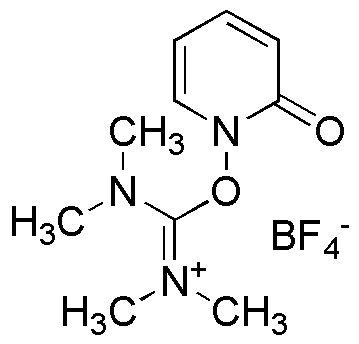2-(2-Pyridon-1yl)-1,1,3,3-tetramethyluronium tetrafluoroborate is widely utilized in research focused on:
- Organic Synthesis: This compound serves as an effective reagent in various organic synthesis reactions, particularly in the formation of complex molecules, making it valuable for chemists developing new pharmaceuticals.
- Polymer Chemistry: It is used as a catalyst in polymerization processes, enhancing the efficiency and speed of producing high-performance polymers, which are essential in industries like packaging and automotive.
- Bioconjugation: The compound plays a critical role in bioconjugation techniques, allowing researchers to attach biomolecules to surfaces or other molecules, which is crucial in drug delivery systems and diagnostics.
- Electrochemistry: It is utilized in electrochemical applications, particularly in the development of sensors and batteries, providing improved performance and stability compared to traditional materials.
- Material Science: This chemical contributes to the development of advanced materials with tailored properties, such as increased thermal stability and enhanced mechanical strength, beneficial in aerospace and electronics industries.
General Information
Properties
Safety and Regulations
Applications
2-(2-Pyridon-1yl)-1,1,3,3-tetramethyluronium tetrafluoroborate is widely utilized in research focused on:
- Organic Synthesis: This compound serves as an effective reagent in various organic synthesis reactions, particularly in the formation of complex molecules, making it valuable for chemists developing new pharmaceuticals.
- Polymer Chemistry: It is used as a catalyst in polymerization processes, enhancing the efficiency and speed of producing high-performance polymers, which are essential in industries like packaging and automotive.
- Bioconjugation: The compound plays a critical role in bioconjugation techniques, allowing researchers to attach biomolecules to surfaces or other molecules, which is crucial in drug delivery systems and diagnostics.
- Electrochemistry: It is utilized in electrochemical applications, particularly in the development of sensors and batteries, providing improved performance and stability compared to traditional materials.
- Material Science: This chemical contributes to the development of advanced materials with tailored properties, such as increased thermal stability and enhanced mechanical strength, beneficial in aerospace and electronics industries.
Documents
Safety Data Sheets (SDS)
The SDS provides comprehensive safety information on handling, storage, and disposal of the product.
Product Specification (PS)
The PS provides a comprehensive breakdown of the product’s properties, including chemical composition, physical state, purity, and storage requirements. It also details acceptable quality ranges and the product's intended applications.
Certificates of Analysis (COA)
Search for Certificates of Analysis (COA) by entering the products Lot Number. Lot and Batch Numbers can be found on a product’s label following the words ‘Lot’ or ‘Batch’.
*Catalog Number
*Lot Number
Certificates Of Origin (COO)
This COO confirms the country where the product was manufactured, and also details the materials and components used in it and whether it is derived from natural, synthetic, or other specific sources. This certificate may be required for customs, trade, and regulatory compliance.
*Catalog Number
*Lot Number
Safety Data Sheets (SDS)
The SDS provides comprehensive safety information on handling, storage, and disposal of the product.
DownloadProduct Specification (PS)
The PS provides a comprehensive breakdown of the product’s properties, including chemical composition, physical state, purity, and storage requirements. It also details acceptable quality ranges and the product's intended applications.
DownloadCertificates of Analysis (COA)
Search for Certificates of Analysis (COA) by entering the products Lot Number. Lot and Batch Numbers can be found on a product’s label following the words ‘Lot’ or ‘Batch’.
*Catalog Number
*Lot Number
Certificates Of Origin (COO)
This COO confirms the country where the product was manufactured, and also details the materials and components used in it and whether it is derived from natural, synthetic, or other specific sources. This certificate may be required for customs, trade, and regulatory compliance.


